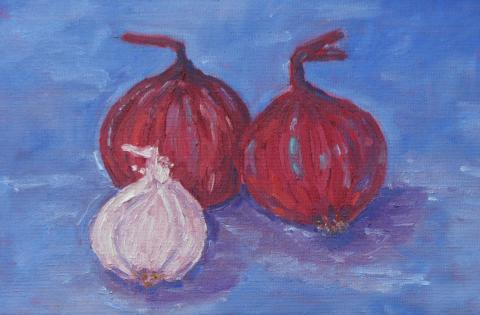
Organic garlic and organic onion are valuable herbs that benefit the body, add flavor to foods and are well known for their healing qualities. They are both members of the allium family, among chives, shallots, and leeks. They are one of the oldest and easiest plants to grow and have been cultivated for millennia. It is said that both garlic and onions originated in Asia but onions and garlic grew wild in the Americas and were popular long before Europeans arrived. Onions were regarded as a god in ancient Egypt – because of an onion’s many layers, it symbolized life. It was eaten there with bread to form the basis of their diet, as well as in Mesopotamia. Both onion and garlic have been part of the Greek diet since 372 B.C.E. However, in ancient Rome, garlic was not a popular food and it wasn’t until the 19th century that Italians began to incorporate it into their recipes.
Garlic and onion are closely related, being members of the allium family, and are a popular addition to many recipes because of their pungent flavors. Both grow as bulbs; the garlic bulb is clustered while the onion is a single bulb.
There are many different types of garlic, each requiring a unique growing environment. The hard necked garlic has a firm stem and it has a strong garlicky flavor. It grows well in colder climates and consists of Porcelain, Rocambole and Purple Stripe varieties. The soft necked garlic has a soft and pliable stem and produces more cloves in the bulb and is milder than the hard necked variety and includes elephant garlic. The Creole garlic grows well in warmer climates and is fairly rare. The bulb has twelve cloves ranging in color from a light pink to purple and has a bit of heat to its flavor. Black garlic can be found in Korean markets and has a chewy texture, much like dried fruit. It has a rich flavor with a hint of plum and vinegar and is used in recipes for people who are not fond of garlic.
There are also several varieties of onions, each with their own unique flavors and uses. The white onion is medium to large in size and is strong and pungent; it is best used in stuffing or recipes that are baked. The Spanish onion is large with yellow or golden skin and is sweet and mild; it is used in salads, salsas and omelets. The red onion is very mild and sweet with a deep purple color and is used in salads and marinades.
Both garlic and onion are valuable tools in keeping the body healthy. They heal many maladies and prevent disease. Garlic contains a compound called allicin, which is the integral healing property. It is heat sensitive, making the healing qualities of garlic ineffective when cooked. It has been scientifically proven that garlic can cure colds, regulate blood pressure, control cholesterol and cure cancer. One of the healing properties of onion is quercetin and has the same healing uses as garlic but is more tolerant of heat and does not lose its healing quality when cooked. It is said that cutting a white onion in half and leaving it overnight will absorb flu bacteria.
Garlic and onion are valuable foods that can be included in a regular menu schedule.








